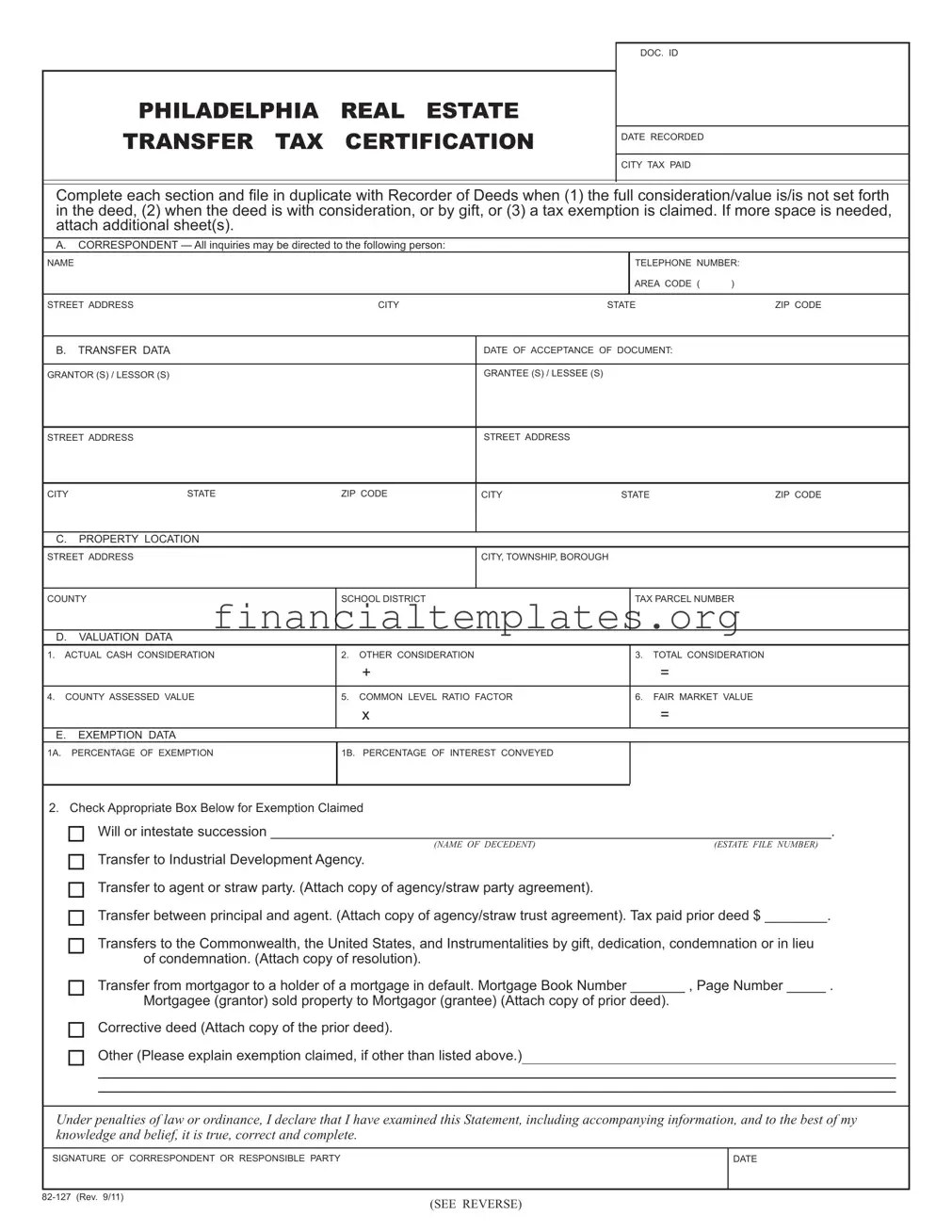INSTRUCTIONS FOR COMPLETING PHILADELPHIA REAL ESTATE TRANSFER TAX CERTIFICATION
Section A Correspondent: Enter the name, address and telephone number of party completing this form.
Section B Transfer Data: Enter the date on which the deed or other document was accepted by the Party(ies). Enter the name and address of the Grantor(s)/Lessor(s) and Grantee(s)/Lessee(s). You must list all names.
Attach additional sheet(s) with full name and address of parties involved, if necessary. You reserve the right to, etc.
Section C Property Location: This section deals with the property being transferred; complete fully. Include the tax parcel number where applicable and the county where the Statement is being filed.
Section D Valuation Data: Complete for all transactions.
1.Actual Cash Consideration - Enter that amount.
2.Other Consideration - Enter the total amount of non-cash consideration such as property and securities. Include mortgages and liens existing before the transfer and not removed thereby, and the agreed consideration for the construction of improvements.
3.Total Consideration - Indicate on line 3 the total of lines 1 and 2. This will be the total consideration for the purchase of the property.
4.County Assessed Value - Enter the actual assessed value of the property as per records of the county assessment office.
5.Common Level Ratio Factor - Enter the county common level ratio factor applicable for the county in which the property is located. An explanation of this factor is provided below.
6.Fair Market Value - Multiply the county assessed value (4) and the county common level ratio factor
(5) and enter the result in block 6.
Section E Exemption Data: Complete only for transactions where an exemption is claimed.
1a. Percentage of Exemption - Enter the percentage of the total consideration claimed as exempt.
1b. Percentage of Interest Conveyed - Enter percentage of interest conveyed.
2.Check Appropriate Box for Exemption Claimed - Boxes are provided for the most often used Pennsylvania realty exemptions. Each is explained in order of appearance on the Realty Transfer Statement of Value form.
"Will or Intestate Succession" - A transfer by Will for no or nominal consideration, or under the intestate succession laws is exempt from tax. Provide the name of the decedent and estate fi le number in the space provided.
"Transfer To or From Agent or Straw Party" - A transfer to or from an agent is exempt from tax if a transfer to or from the agent's principal by the third party would be exempt from tax. Attach a copy of the agency/straw party agreement and a statement explaining the exemption claimed.
"Transfer Between Principal and Agent" - A transfer between an agent or principal for no or nominal consideration is exempt. Attach a copy of the agency/straw trust agreement. Enter the tax paid on the prior deed in the space provided.
"Transfer to the Commonwealth, the United States and Instrumentalities by Gift, Dedication, Condemnation or in lieu of Condemnation." - (Attach a copy of resolution)
"Transfer from Mortgagor to Holder of a Mortgage in Default" - A transfer from a mortgagor to a holder of a mortgage in default, whether pursuant to a foreclosure or in lieu, thereof, is exempt. Provide the mortgage book number and page number where mortgage is recorded, and property was transferred directly from the Mortgage to the Mortgagor.
"Corrective Deed" - A deed for no or nominal consideration which corrects a deed that was previously recorded but does not extend or limit the title or interest under the prior deed is exempt from tax. (Attach copy of the prior deed).
"OTHER" (PLEASE EXPLAIN EXEMPTION CLAIMED IF OTHER THAN THOSE LISTED ABOVE.) When claiming an exemption other than those listed, you must specify which exemption is claimed. When possible, provide the applicable statutory citation. Attach additional pages, if necessary.
COMMON LEVEL RATIO FACTOR
This is a property valuation factor provided by the Department of Revenue by which the county assessed value is multiplied to determine the taxable value of real estate for all non-arm's length transactions, leases and acquired companies. The factor is base on the common level ratio established by the State Tax Equalization Board. The common level ratio is a ratio of assessed values to current fair market values as reflected by actual sales of real estate in each county. A statewide list of the factors is available at the Recorder of Deeds' offi ce in each county.
THIS STATEMENT MUST BE SIGNED BY A RESPONSIBLE PERSON CONNECTED WITH THE TRANSACTION.

